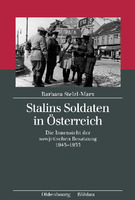Stalins Soldaten in Österreich
Die Innensicht der sowjetischen Besatzung 1945–1955
Author(s)
Stelzl-Marx, Barbara
Collection
Austrian Science Fund (FWF)Language
GermanAbstract
As Soviet troops first set foot on Austrian territory on March 29, 1945 near Klostermarienberg, they found themselves in a hostile, perplexing and largely unknown world. The Austrians by no means greeted their Eastern "liberators from the fascist yoke" with open arms. Given the first encounters with the Austrian population a variety of stereotypes developed, supporting images of the enemy and the other. Soviet propaganda together with the war experiences anchored these ideas deep into the sub-conscious. However, also ideas of the West that had been aroused by film and literature were now confronted with reality.
The Red Army's glorious and triumphant end of WWII was followed by their ten-year long occupation of Austria, where hundreds of thousands of Soviet soldiers and officers, their wives and children and also civil occupational personnel were linked to Austria for many months and sometimes even years. Moscow attempted (often in vain) to train their troops in line with a "higher political oversight," to boost their military discipline and to strengthen their "political and moral status." From the Soviet point of view, direct confrontation with the Austrian population, but also the Western occupying forces rescued them from the danger of being a "hostile takeover." Doubts about the superiority of the Communist system, breaches of regulations as well as offences, which were really "only" a matter of criminal law, were considered politically motivated and served as a sign of the ideological and political fickleness of the concerned party. Reprisals for the afore-mentioned infractions could be severe and sometimes meant the death penalty.
The Austrian view of occupation, Austrian everyday life in the Soviet occupation zone or the most important Topoi from the Red Army is well documented and preserved. This research is owed largely to the individual experiences, impressions and responses of the occupying forces themselves.
This work is focused on the EXPERIENCE of the soviet "lifeworld" in Austria, which includes among other things the occupation organization, the discipline and prosecution, the daily work, the everyday live in the barracks or the leisure activities; the PERCEPTION mirrored in written and oral testimonies and the institutionalized as well as private MEMORY in the former Soviet Union. The beginning depicts the macro-level structure and functioning of the Soviet occupational apparatus as well as the historical background. This meticulous retracing of history offers new insights into the question of the perception of the other and the development of specific Topoi. Als sowjetische Truppen am 29. März 1945 bei Klostermarienberg erstmals österreichischen Boden betraten, tauchten sie in eine feindliche, weitestgehend unbekannte und nur schwer verständliche Welt ein, die die östlichen "Befreier vom faschistischen Joch" durchaus nicht mit offenen Armen begrüßte. Angesichts der ersten Begegnungen mit der österreichischen Bevölkerung kamen nun vielfach jene stereotypen Feind- und Fremdbilder zum Tragen, die die sowjetische Propaganda gemeinsam mit den Kriegserfahrungen tief im Unterbewusstsein verankert hatte. Aber auch durch Film und Literatur geprägte Vorstellungen des Westens wurden mit der Realität konfrontiert.
Dem für die Rote Armee ruhm- und siegreichen Ende des Zweiten Weltkrieges folgte die zehnjährige Besatzung Österreichs, die hunderttausende sowjetische Soldaten und Offiziere, ihre Frauen und Kinder sowie ziviles Besatzungspersonal für mehrere Monate, aber auch Jahre an Österreich binden sollte. Moskau versuchte (häufig vergeblich), die Truppen zu "hoher politischer Wachsamkeit" zu erziehen, ihre militärische Disziplin zu steigern und den "politisch-moralischen Zustand" zu stärken. Die direkte Konfrontation mit der österreichischen Bevölkerung, aber auch mit westlichen Besatzungsangehörigen barg aus sowjetischer Sicht die Gefahr einer "feindlichen Einflussnahme" in sich. Zweifel an der Überlegenheit des kommunistischen Systems, Regelverstöße sowie Vergehen, die eigentlich "nur" strafrechtlich relevant waren, galten als politisch motiviert und als ein Zeichen der ideologischen und politischen Wankelmütigkeit des Betroffenen. Dies konnte strenge Repressalien bis hin zur Todesstrafe nach sich ziehen.
Während die österreichische Sichtweise der Besatzung, der österreichische Alltag in der sowjetischen Besatzungszone oder die wichtigsten Topoi von den Rotarmisten gut dokumentiert und aufgearbeitet sind, stehen Forschungen zu den individuellen Erlebnissen, Eindrücken und Verarbeitungsformen durch die Besatzungssoldaten selbst bisher weitestgehend aus.
Im Zentrum der vorliegenden Arbeit stehen die ERFAHRUNG der sowjetischen Lebenswelt in Österreich, die u. a. die Besatzungsorganisation, Disziplin und Strafverfolgung, die tägliche Arbeit, das Alltagsleben in den Kasernen oder die Freizeitgestaltung einschließt; die WAHRNEHMUNG im Spiegel schriftlicher und mündlicher Zeugnisse, und die institutionalisierte wie private ERINNERUNG in der ehemaligen Sowjetunion. Einleitend werden im Rahmen der Makroebene Struktur und Funktion des sowjetischen Besatzungsapparates sowie die historischen Rahmenbedingungen geschildert. Diese akribische Spurensuche soll nicht zuletzt für die Frage nach der Wahrnehmung des Fremden und der Herausbildung spezifischer Topoi neue Einsichten eröffnen.


 Download
Download